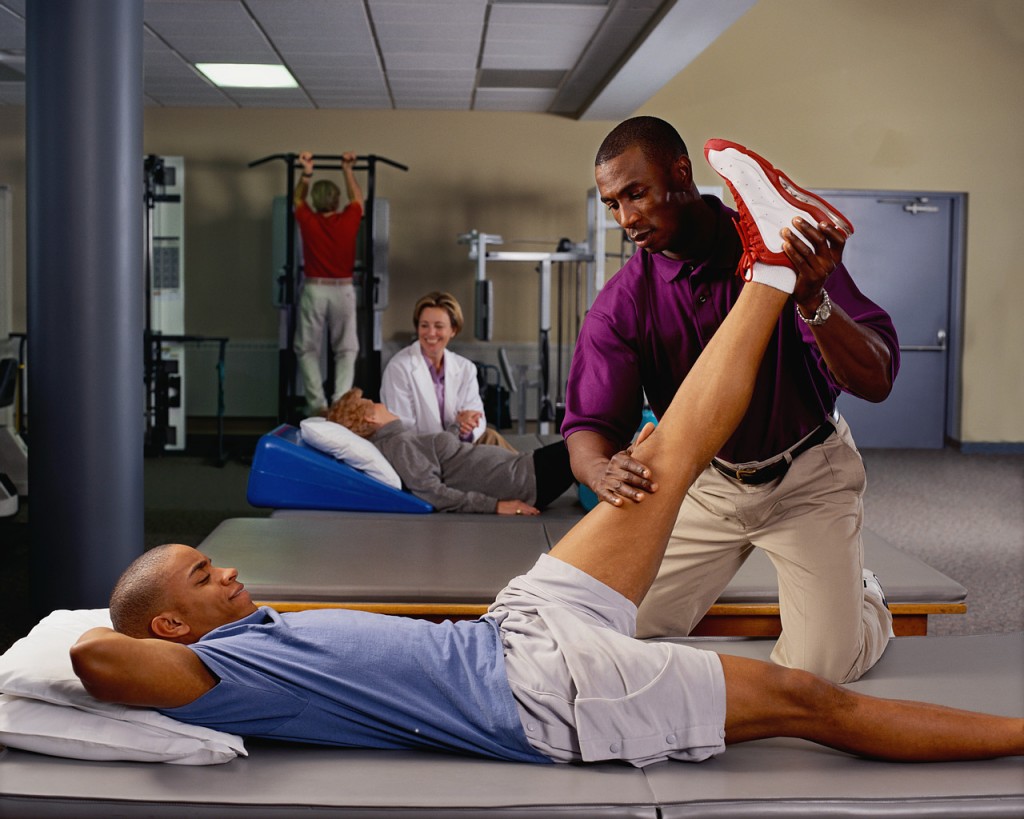| Physical Therapists: A Quick Look |
| Median Salary |
$79,860 per year
$38.39 per hour |
| Entry-level Education |
Doctoral degree |
| On-the-job training |
No |
| Primary employers |
Private Offices, Hospitals, Nursing Homes |
| Number of positions (U.S.) |
204,200 |
| Job Growth (2012-2022) |
36 percent (Much quicker than the national average)
|
| New positions (2012-2022) |
73,500 |
 Physical Therapist Job Description Physical Therapist’s job description revolves around helping people suffering from pain regain their ability to move. They also help these clients with pain management. The work of PT’s revolves around the core of physical rehabilitation for both people suffering from chronic ailments as well as for people who have sustained physical trauma. Read more
Physical Therapist Job Description Physical Therapist’s job description revolves around helping people suffering from pain regain their ability to move. They also help these clients with pain management. The work of PT’s revolves around the core of physical rehabilitation for both people suffering from chronic ailments as well as for people who have sustained physical trauma. Read more
Physical Therapist Salary Physical Therapy is a highly sought after position because it pays a lucrative salary and also offers a steady projected job outlook through the next decade. The Bureau of Labor Statistics’ data places the median annual Physical Therapist salary right around $79,860. Read more
How to Become a Physical Therapist To become a PT, you must attain a doctoral license in Physical Therapy. Other medical professions may differ in terms of licensing requirements from one state to the next. However, that is not the case with PT’s. All states demand that PTs be licensed. You can read all about how to become a Physical Therapist in this job post. Read more
Job Outlook As with many professions in the field of medicine, physical therapy will see a massive job demand boost from 2012 to 2022 according to data from the Bureau of Labor Statistics. The Bureau expects this field to grow by 36 percent (which is higher than the projected outlook for other health diagnosis and treating practitioners). Read more
Physical Therapist The profession of physical therapy is highly sought after because it pays very well and also has a great projected job outlook over the next decade. Given the fact that the average median yearly salary for all occupations in the United States stands at $34,750, it’s safe to say that physical therapists earn a lot of money on average. May 2012 data from the Bureau of Labor Statistics places their median annual wage at $79,860. The bottom 10 percentile of earners make just under $55,620 per year. Earnings for the top 10 percentile typically exceed $112,020. All in all, these professionals earn better wages on average than medical care diagnosticians and treatment practitioners. They typically earn a yearly median wage of $73,410.
How to Begin a Professional Career as a Physical Therapist In order to become a physical therapist, you need to obtain a doctoral license in Physical Therapy. Though other medical professions may differ in terms of licensing from one state to the next, this is not the case with PT's. Every state in the U.S. demands that these professionals be licensed. Your Doctor of Physical Therapy degree must be fully accredited from the Commission on Accreditation in Physical Therapy Education. Luckily, over 200 programs throughout the United States are fully accredited. Such a program usually lasts for three years. Enrollment requires a bachelor’s degree, as well as some mandatory coursework in biology, physiology, chemistry, anatomy, physics, and so on. Applicants must follow the Physical Therapist Centralized Application Service procedures. During such programs, you typically take courses on anatomy, physiology, biomechanics, pharmacology, and neuroscience. You must also take an internship with a clinic where you’ll get the opportunity to acquire hands-on experience under the supervision of trained experts. After you complete the doctoral degree program, you can also choose to enroll in a residency program (also through a clinic). Such programs typically take one year to complete and allow you to become more specialized in a particular field of care. Post-residency options include advanced clinical specialization through fellowships. In order to receive a license, you will find that the requirements vary from one state to the next. However, all states require certification in one of the eight areas of clinical specialization provided by the American Board of Physical Therapy Specialties. To get this license in either orthopedics, geriatrics, or another field, you must pass an exam and complete a 2,000-hour clinical internship (or a board-approved residency program). In some states, you must also pass a law exam and clear a background check before you can attain your license. Make sure you check the prerequisites in your particular state before applying for a license.
Physical Therapist Job Description The physical therapy job description is quite demanding. Most professionals work in an office environment and observe regular business hours. However, the Bureau of Labor Statistics notes that about one quarter of PT's worked part time. Also, some of them work very long hours which include weekends and evenings. In a nutshell, the physical therapist job description involves helping people in pain (either because of illness and injury) regain their ability to move and deal with pain management. The work of a PT remains at the core of physical rehabilitation for both people suffering from chronic ailments as well as for people who sustained physical injuries. Aside from the required qualifications described above, PTs must display a specific set of qualities:
- Compassionate. As is the case with most jobs in the medical profession, PTs are expected to want to help people and to be able to empathize with their patients’ often grueling physical pain.
- Good with people. Most of the time a PT spends on the job is spent taking care of patients and directly interacting with them. As such, a good PT is supposed to like people, listen to their problems patiently, efficiently explain therapies and treatments, offer motivation, and counsel them through their worries, issues, and problems.
- Dexterous. The vast majority of the work is performed with the hands. PTs provide therapeutic exercise, manual therapy, physical assistance, and even massage to their patients.
- Able to take effort. A workday is usually spent on one’s feet, running about from one patient to the next. That’s why good PT's should enjoy physical effort and have the stamina to sustain it.
- Resourceful. PT's should know that no two patients are the same – which is why they also need to be able to customize treatment plans and adapt them to a particular patient’s needs.
- Attentive to details. They are expected to notice details and have strong capacities for analysis, in order to properly diagnose their patients, assess possible methods of treatment, and offer them safe health care solutions, which also work.
On a typical day on the job, a physical therapist will complete any of the following tasks:
- Review a patient’s medical history, including referrals from other medical professionals (surgeons, general practitioners, other specialists).
- Offer a diagnostic, based on a patient’s dysfunctional pattern of movement. This can either be observed by having the patient walk, stand, or perform other physical activities, or it can be inferred from the patient’s own narrative of their problems.
- Devise a treatment plan, which needs to include goals for the patient’s rehabilitation, outlined in terms of projected results.
- Talk to the patient, their families and other caregivers, in order to instruct them on the treatment plan and explain what they should expect and what are some of the best ways in which they can cope with rehabilitation, from pain, to other issues.
- Implement the treatment plan, with the use of therapy, stretching, physical activity, and physical therapy equipment. This plan should improve their pain, help them start moving more and with better ease, protect them from future injuries, and improve the overall state of their health.
- Assess the implementation of the treatment plan, monitor the patient’s progress, and amending the treatment in accordance to the patient’s evolution and goals.
Through the kind of treatment they offer, physical therapists help patients deal with a great array of problems. These problems vary from arthritis, sprains, strains, and some of the most typical injuries to the back and neck. Complex issues may include neurological problems, amputated limbs, strokes and cerebral palsies, and all types of work-related and sports injuries. Their therapies, which can also be referred to as ‘modalities’ are based on all sorts of techniques and equipment: crutches, walkers, and wheelchair, electrode and electric stimulation for injury and pain treatment, or heat and cold application. It’s very important to note that the work of a PT differs from one patient to the next. Patients recovering from cerebral palsy will obviously receive different treatment than a injured athlete. Many of them specialize in one type of care. But, some address several types of issues.
Job Outlook As with many other medical professions, physical therapy will see a massive job demand boost from 2012 to 2022, says the Bureau of Labor Statistics. The field should grow by 36 percent, which is higher than the projected outlook for health diagnosis and treating practitioners (20 percent), and far superior to the average for all occupations (11 percent). This increase in demand can be chalked up to the rapid aging of the baby boomer generation, whose members are also trying to stay fit and active until later in life. At the same time, the increase in numbers of obese patients and sufferers of diabetes will also up the demand for PTs. Meanwhile, as medical technology continues to evolve, it is likely that physical therapists will be able to treat an ever greater assortment of patients, from those who have sustained trauma from injuries to newborns with birth defects. PTs will help such patients recover from surgery at a quicker pace.

 Physical Therapist Job Description Physical Therapist’s job description revolves around helping people suffering from pain regain their ability to move. They also help these clients with pain management. The work of PT’s revolves around the core of physical rehabilitation for both people suffering from chronic ailments as well as for people who have sustained physical trauma. Read more
Physical Therapist Job Description Physical Therapist’s job description revolves around helping people suffering from pain regain their ability to move. They also help these clients with pain management. The work of PT’s revolves around the core of physical rehabilitation for both people suffering from chronic ailments as well as for people who have sustained physical trauma. Read more
Leave a Reply